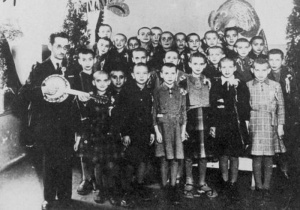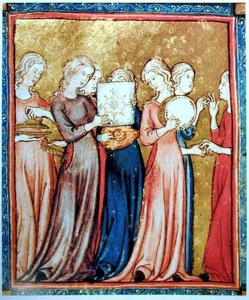Music That Evokes the Beis HaMikdash: 12th Annual North American Jewish Choral Festival
We live in an age of longing. An age of intense longing one thousand nine hundred and twenty nine years old. We get up from Tisha b’Av not consoled, but resigned to a harsh exile of longing, no matter how comfortable we may be personally. And yet there is hope. Not only the hope that we constantly place in the ribbono shel olam, but the hope that we actually experience. At special large gatherings of Jews we can taste the joy of the ingathering from the four corners of the earth to rejoice in a rebuilt Temple. When we are united on Yom Tovim, friends and family amongst a large congregation davening or saying hallel, this reminds us of what it will be like to stand before the Third Temple. At the sium for Daf Yomi in Madison Square Garden, when over twenty thousand Jews responded to a kaddish in unison or spontaneously began to dance in the aisles and at their seats over the joy of learning Torah; these special moments of Jewish unity allows us to envision the Temple courtyards. These are the special moments of hope in golus. And included in those special moments are the magic that erupts as six hundred people sing together united in one Jewish text, one kevanah and even one breath. It will be happening at the Twelfth Annual North American Jewish Choral Festival, August 5-9 at the Nevele Grande Hotel in Ellenville, New York.

This amazing festival has been going on for the past twelve years under the guidance of Matthew Lazar, the founder and director of the Zamir Choral Foundation. The Zamir Foundation was founded to foster Jewish commitment through choral singing, evoking a sense of national community, a celebration of Jewish creativity in music and, since choral music is uniquely text based, a strengthening of Jewish literacy. That foundation grew out of the Zamir Chorus that he has directed since 1972. In addition he has created Hazamir, the National Jewish High School Choir for high school students; the National Jewish Chorale to present international performances and Zamir’s Open Sing which is normally held annually on or near December 25th in the New York Metropolitan area as an alternative to the ubiquitous “holiday fare” at that time of year.
The choral festival is under the direct organization of Rabbi Daniel Freelander and Dr. Marsha Byran Edelman. In some ways it is more of a participatory conference than a festival for audiences (even though listeners are welcome), bringing together thirteen different choruses from Chicago, New York, Washington, D.C., Philadelphia, Montreal, MetroWest, Tenafly, and Cherry Hill, New Jersey. In addition there are three smaller ensembles that are scheduled to perform after the four main evening concerts. In all over ninety different choral works will be performed. But the evening performances are only the end of the process that starts every day with davening, breakfast, a community sing and then proceeds with a full spectrum of workshops for the entire four day festival.
There are workshops for listeners that includes nusach as a mode of prayer, the music of the American Yiddish Theater, Jewish music on stage and the music and culture of Jewish Calcutta. There are the major workshops for singers that include sight-singing, choral conducting, and cantorial recitative for the Shabbat. Further workshops include choral music for Chanukah, Jewish music history, the Yiddish songs, niggunim and klezmer tunes collected by Russian folklorist Moshe Beregovsky, Ladino songs, Baghdadi-Indian traditional Passover songs, Yiddish choral music, Yom Tov trope and High Holiday a cappella music, and even music as midrash on sacred text. This extensive series of workshops are taught by a wide range of cantors, educators, conductors and composers. This is clearly the place to be if you are interested in Jewish Music and especially Jewish Choral Music.
The festival attracts Jews from all facets of the American Jewish community, from amateurs to seasoned choral singers. The majority of the music is performed unaccompanied (a cappella) but some is sung to the accompaniment of piano or small instrumental ensembles. By its varied program and workshop series, the festival encourages new composers of Jewish music along with the appreciation of over five hundred years of Jewish choral music.
Those who come to the festival as individuals participate in one of six “Instant Ensembles” after they are grouped according to their ability to sight read music. Members of the visiting choruses join them in five rehearsals that lead up to their grand performance at the end of the festival. In addition, each morning, after breakfast, there is the exciting and awesome “Community Sing” comprised of all the festival participants, close to six hundred individuals. They will be singing thirteen different selections that have been practiced in their individual choral groups. It is here that the unity of the Jewish people becomes palpable as each individual is united with their fellow Jew in breath, text, music and song.
Of course, after all is said and done, it is the music that matters. Last week I had the privilege to hear the Zamir Chorus rehearse and it was truly moving. The interaction between the conductor, Matthew Lazar and his chorus of 40 was intense; a working creative relationship to draw the music out with love, discipline, exactitude and patience. They practiced a new commissioned work by David Burger, Misheberach to be premiered at the Festival. It is in a contemporary American choral style; gently swelling in growing passion, a melodic ascent expressing our pleas for a blessing of health for our loved ones.

HaMavdil by the 20th century Israeli composer, Oden Partos is an evocative combination of Mediterranean musical style and Western harmonics. The work is a study in contrasts, exciting layers piling up on one another until the tempo changes and shifts perspective, much like our experience when we re-enter the world after the bliss of Shabbos. The upbeat ending of “Eliyahu ha navi… may he come quickly with Moshiach ben Dovid” was sung by the chorus in a series of harmonies, recitatives, and crescendos that expressed their excitement, energy and most of all, camaraderie.
Me’al Pisgat Har Hatzofim, a Yiddish folk song with Hebrew lyrics by Avigdor Hameiri (1890-1970) was stirringly sung by the chorus in its tenderness and beauty. It is overwhelming in its longing for Jerusalem as it ends with “Yerushalayim, Yerushalayim, ani lo azuz mipoh, Yerushalayim, Yerushalayim, yavo Hamashiach, yavo” (Jerusalem, Jerusalem, I will not move from here, Jerusalem, Jerusalem, the Messiah will come, he will come).
Again, we must return to the central meaning for us in Jewish choral music. It is quite simply the answer to the longing for a glimpse into the precincts of the Holy Temple of the near future. There the Leviim will sing, with their instruments, the daily songs of David. We shall be uplifted then in a way that we can capture right now at this North American Jewish Choral Festival. Certainly there is almost nothing quite as fine as when Jews raise their voices, hearts and souls together, in praise of Hashem.
12th Annual North American Jewish Choral Festival
Nevele Grand Hotel, Ellenville, New York
August 5-9, 2001
For Information: contact Dr. Marsha Bryan Edelman c/o Zamir Choral Foundation 212 362 3335 or email [email protected]